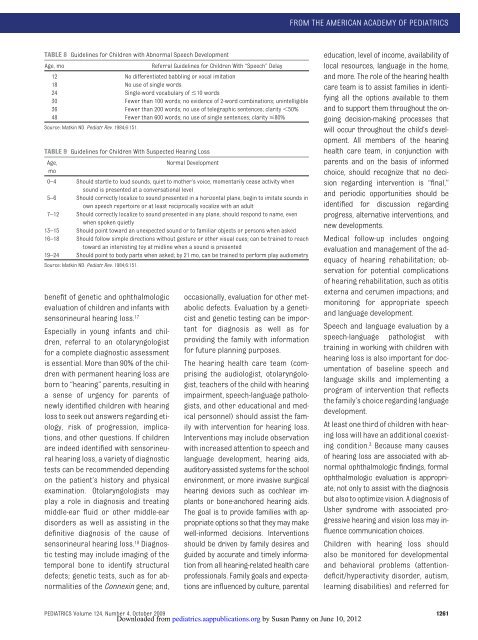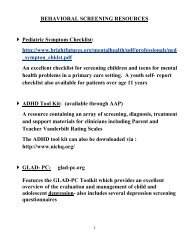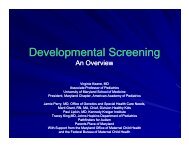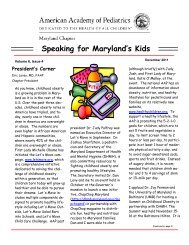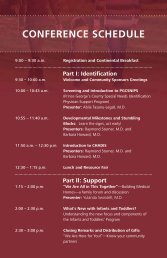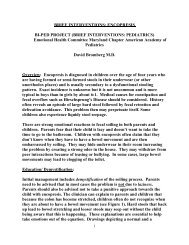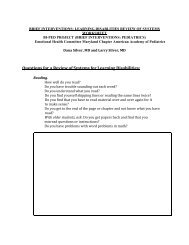AAP Hearing Assessment and Recommendations - Maryland ...
AAP Hearing Assessment and Recommendations - Maryland ...
AAP Hearing Assessment and Recommendations - Maryland ...
You also want an ePaper? Increase the reach of your titles
YUMPU automatically turns print PDFs into web optimized ePapers that Google loves.
FROM THE AMERICAN ACADEMY OF PEDIATRICSTABLE 8 Guidelines for Children with Abnormal Speech DevelopmentAge, moReferral Guidelines for Children With “Speech” Delay12 No differentiated babbling or vocal imitation18 No use of single words24 Single-word vocabulary of 10 words30 Fewer than 100 words; no evidence of 2-word combinations; unintelligible36 Fewer than 200 words; no use of telegraphic sentences; clarity 50%48 Fewer than 600 words; no use of single sentences; clarity 80%Source: Matkin ND. Pediatr Rev. 1984;6:151.TABLE 9 Guidelines for Children With Suspected <strong>Hearing</strong> LossAge,Normal Developmentmo0–4 Should startle to loud sounds, quiet to mother’s voice, momentarily cease activity whensound is presented at a conversational level5–6 Should correctly localize to sound presented in a horizontal plane, begin to imitate sounds inown speech repertoire or at least reciprocally vocalize with an adult7–12 Should correctly localize to sound presented in any plane, should respond to name, evenwhen spoken quietly13–15 Should point toward an unexpected sound or to familiar objects or persons when asked16–18 Should follow simple directions without gesture or other visual cues; can be trained to reachtoward an interesting toy at midline when a sound is presented19–24 Should point to body parts when asked; by 21 mo, can be trained to perform play audiometrySource: Matkin ND. Pediatr Rev. 1984;6:151.benefit of genetic <strong>and</strong> ophthalmologicevaluation of children <strong>and</strong> infants withsensorineural hearing loss. 17Especially in young infants <strong>and</strong> children,referral to an otolaryngologistfor a complete diagnostic assessmentis essential. More than 90% of the childrenwith permanent hearing loss areborn to “hearing” parents, resulting ina sense of urgency for parents ofnewly identified children with hearingloss to seek out answers regarding etiology,risk of progression, implications,<strong>and</strong> other questions. If childrenare indeed identified with sensorineuralhearing loss, a variety of diagnostictests can be recommended dependingon the patient’s history <strong>and</strong> physicalexamination. Otolaryngologists mayplay a role in diagnosis <strong>and</strong> treatingmiddle-ear fluid or other middle-eardisorders as well as assisting in thedefinitive diagnosis of the cause ofsensorineural hearing loss. 18 Diagnostictesting may include imaging of thetemporal bone to identify structuraldefects; genetic tests, such as for abnormalitiesof the Connexin gene; <strong>and</strong>,occasionally, evaluation for other metabolicdefects. Evaluation by a geneticist<strong>and</strong> genetic testing can be importantfor diagnosis as well as forproviding the family with informationfor future planning purposes.The hearing health care team (comprisingthe audiologist, otolaryngologist,teachers of the child with hearingimpairment, speech-language pathologists,<strong>and</strong> other educational <strong>and</strong> medicalpersonnel) should assist the familywith intervention for hearing loss.Interventions may include observationwith increased attention to speech <strong>and</strong>language development, hearing aids,auditory-assisted systems for the schoolenvironment, or more invasive surgicalhearing devices such as cochlear implantsor bone-anchored hearing aids.The goal is to provide families with appropriateoptions so that they may makewell-informed decisions. Interventionsshould be driven by family desires <strong>and</strong>guided by accurate <strong>and</strong> timely informationfrom all hearing-related health careprofessionals. Family goals <strong>and</strong> expectationsare influenced by culture, parentaleducation, level of income, availability oflocal resources, language in the home,<strong>and</strong> more. The role of the hearing healthcare team is to assist families in identifyingall the options available to them<strong>and</strong> to support them throughout the ongoingdecision-making processes thatwill occur throughout the child’s development.All members of the hearinghealth care team, in conjunction withparents <strong>and</strong> on the basis of informedchoice, should recognize that no decisionregarding intervention is “final,”<strong>and</strong> periodic opportunities should beidentified for discussion regardingprogress, alternative interventions, <strong>and</strong>new developments.Medical follow-up includes ongoingevaluation <strong>and</strong> management of the adequacyof hearing rehabilitation; observationfor potential complicationsof hearing rehabilitation, such as otitisexterna <strong>and</strong> cerumen impactions; <strong>and</strong>monitoring for appropriate speech<strong>and</strong> language development.Speech <strong>and</strong> language evaluation by aspeech-language pathologist withtraining in working with children withhearing loss is also important for documentationof baseline speech <strong>and</strong>language skills <strong>and</strong> implementing aprogram of intervention that reflectsthe family’s choice regarding languagedevelopment.At least one third of children with hearingloss will have an additional coexistingcondition. 3 Because many causesof hearing loss are associated with abnormalophthalmologic findings, formalophthalmologic evaluation is appropriate,not only to assist with the diagnosisbut also to optimize vision. A diagnosis ofUsher syndrome with associated progressivehearing <strong>and</strong> vision loss may influencecommunication choices.Children with hearing loss shouldalso be monitored for developmental<strong>and</strong> behavioral problems (attentiondeficit/hyperactivitydisorder, autism,learning disabilities) <strong>and</strong> referred forPEDIATRICS Volume 124, Number 4, October 2009 1261Downloaded from pediatrics.aappublications.org by Susan Panny on June 10, 2012


